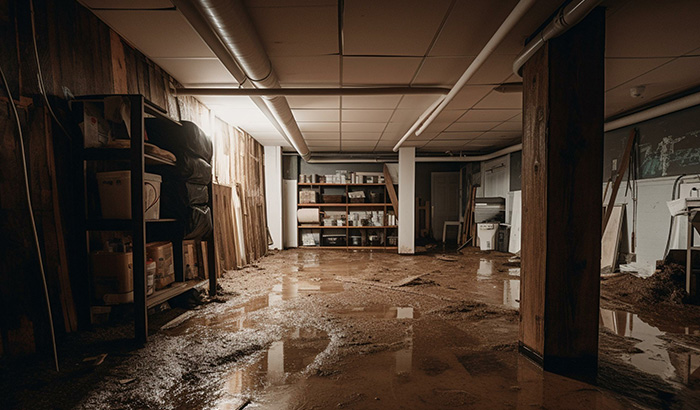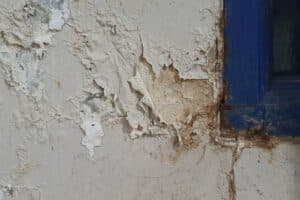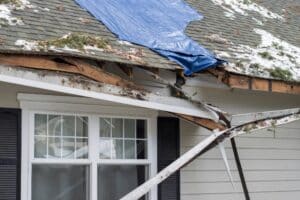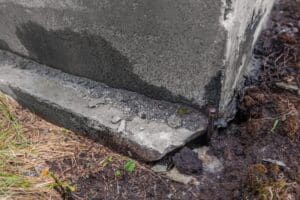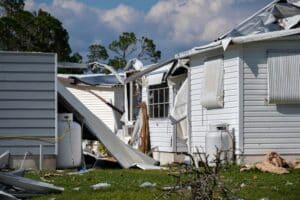Dealing with water damage is no one’s idea of fun, but knowing how to protect your house from a flood will make a huge difference in recovery.
Walking into a flood is a nightmare scenario that leaves you anxious, overwhelmed, and full of relentless questions. Fortunately, with the right knowledge and preparation, minimizing the damage, protecting your wallet, and restoring your home ASAP is achievable.
So, let’s dive in! We cover everything you need to know about water and flood damage so you’re prepared to respond quickly when disaster hits. Here’s how to protect your property from water’s wrath.
Flooding: 101
Flooding happens when water exceeds its usual confines and spreads over land that is typically dry. Floods are the second-most widespread natural disaster on Earth, and all 50 states are vulnerable. They often happen during heavy rainstorms, when snow melts too quickly, as ocean waves overflow, when runoff collects in rivers, if a dam breaks, and in various other scenarios.
Some floods build gradually enough that forecasters will predict where they will occur days or weeks in advance. Flash floods, on the other hand, occur within a handful of minutes or hours. Floods might happen in a one-and-done fashion, or last up to days, weeks, or months. With so much ambiguity surrounding flood severity and timing, thorough storm preparedness offers the utmost peace of mind.
Assess your property’s risk
One of the first steps you’ll want to take when preparing for storms is to check out how likely your property is to flood or suffer water damage. Start by assessing if you’re in an area prone to flooding or close to water sources like rivers, lakes, or the coast. Take a peek at flood maps and chat with local authorities to gauge the flood risk in your area and how serious it could be.
Next, consider how high your property sits and whether it might be vulnerable to storm surges or rising water levels during extreme weather. Take into account the condition of your property’s drainage systems and any potential weak points needing reinforcement to withstand heavy rainfall or flooding.

Elevate appliances
Appliances are a key item you’ll want to protect against storm damage. They’re expensive to replace, cumbersome to move, and might exacerbate damage if they’re broken. Make sure all your appliances and electrical utilities are raised above flood level. It’ll save you from a heap of costly damage and keep your place running smoothly after a flood hits.
If you’re in a single-story home or don’t want to lug your fridge upstairs, easily create some makeshift platforms using cinder blocks and wood. They’re easy to put together, take apart, and stash away once the flood danger has passed. And if the floodwaters start creeping up, don’t forget to cut off your home’s electricity before things get wet and risky.
Apply sealants
Sealants are a crucial step to protect your house from a flood and keep water at bay. Start by sealing up any foundation cracks to prevent even a drop of water from seeping in. Grab some masonry caulk or mortar and get to work filling in any gaps you find. If you notice the problem persisting, explore more permanent solutions as time allows.
But we’re not done yet–don’t forget the crevices in your walls, windows, and doors too. While you can’t control the rain, you can certainly take steps to minimize the number of entry points that water will find its way through into your residence. So, apply those sealants and keep your home safe and dry despite the weather.
Invest in a sump pump
Many homeowners have heard of sump pumps, but there’s plenty of confusion surrounding their purpose and capabilities. A sump pump is a device installed in a pit dug at your home’s lowest point, typically in the basement or crawl space. Despite its unassuming appearance, this small addition plays a critical role in preventing basement flooding.
By removing water from the pit and redirecting it to a nearby storm drain, a sump pump effectively prevents groundwater from reaching the level of your basement floor. As they fight off threats like basement flooding and mold, sump pumps are essential. Keep up with regular maintenance, and you’ll be rewarded with a cozy, dry home for years to come.
Utilize foundation vents
Foundation vents offer an alternative solution to sump pumps for managing water and preventing flooding. Here’s how they work: Foundation vents provide pathways for water to flow through your house rather than accumulating around it. This helps relieve pressure on your walls and basement windows while providing an exit route for floodwater.
As warm air rises inside your home, it naturally draws air in through foundation vents from the outside. This helps regulate moisture levels in the foundation, particularly on warmer days, by reducing humidity and maintaining dry conditions. Foundation vents offer a practical and effective way to manage moisture and protect against water damage.
Address leaks promptly
Moisture creeping into your home is a welcoming invitation for mold growth, and that’s definitely not something you want lingering around. Mold is a known allergen linked to asthma and other respiratory issues. With this in mind, pounce on water leaks as soon as you spot them to keep your family safe.
Keep an eye out for telltale signs of leaks, like water pooling in the basement or suspicious damp patches on your ceiling. Regularly inspect your pipes for any signs of trouble, whether it’s unusual buckling, visible droplets, or signs of corrosion. If you do uncover a leak, don’t wait around—patch it up pronto or call your local experts to fix the problem quickly.
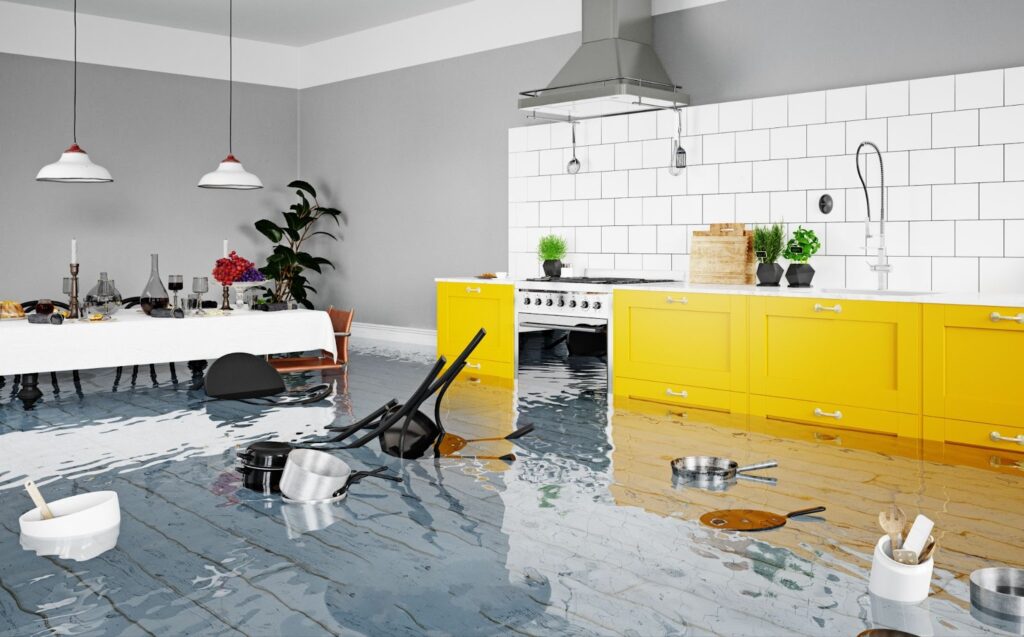
Don’t sleep on yard care
We’ve covered several items to tackle inside your home to prevent flooding, but what about the outside? Taking care of your yard is equally important when you’re aiming for optimal storm preparedness.
When debris, such as leaves, sticks, and other clutter, accumulate in your yard, they tend to clog drains, gutters, and stormwater systems. Any obstruction that impedes the natural flow of water will cause it to pool in low-lying areas, such as your yard or basement.
Start by giving your drains a thorough clean-out, getting rid of any debris that has accumulated over the weeks. Grab a rake and tackle any leaves and sticks strewn across your yard. Next, a brush or rake will come in handy for removing any stubborn debris and leaves from your storm drains. Once you’ve cleared everything out, simply dump the debris into your yard’s garbage bin.
By regularly clearing debris, you create pathways for water to flow freely away from your home. This helps minimize the risk of water buildup and flooding during heavy rainfall or storms. Maintaining a well-groomed yard with proper grading will help divert water away from your home’s foundation, further minimizing the likelihood of flooding.
Inspect your roof
While you’re outside, take advantage of this time and inspect your roof. Start by checking for cracked bricks, loose mortar, and any signs of leaks in the attic. Then, grab a ladder and climb up to take a closer look at the roof itself. Keep an eye out for damaged, missing, or loose shingles, and don’t hesitate to call in the professionals to repair your roof as needed.
Secure flood insurance
Flood insurance is something you definitely don’t want to overlook, especially since most home insurance plans won’t protect against water damage. With climate change bringing more intense rainfall, you might be at risk of flooding without even realizing it.
But here’s the good news: your home insurance provider can often help you secure flood insurance through either a government program or a private insurer. When you’re figuring out your coverage limits and assessing the value of your home and belongings, don’t forget to factor in the cost of flood insurance along with your regular home policy.
Ensure proper drainage
Drainage is another key component if you want a water-free residence. The ground around your property should slope away from the foundation. Next time it rains, keep an eye out to make sure the water flows away from your home and doesn’t pool up anywhere on your property. If you notice overflowing gutters, soggy ground, or a damp basement, take a closer look at your drainage systems.
To beef up your home’s flood resistance, consider installing backwater valves. These handy devices will help prevent flood water from backing up into your home, adding an extra layer of protection against pesky water damage.
Acquire generators
Generators are absolute lifesavers, especially after a major flood knocks out the power. Waiting weeks for electricity to come back on is no picnic. Not only does it mean food spoiling in the fridge, but it also puts your sump pump out of commission, leaving your basement vulnerable to flooding. Plus, without power, you’re left in the dark – literally and figuratively – unable to charge your phone or connect to WiFi to reach emergency services if needed.
While a whole-house generator is the gold standard for storm preparedness, it’s not always feasible for everyone’s budget. That’s where portable generators come in handy. Depending on the size and cost, hook up enough electricity to keep essential appliances like your fridge, sump pump, and lights up and running. It’s a game-changer for keeping your home functional and comfortable, even when the power’s out.
Prep some sandbags
Sandbags are a lifesaver in times of water trouble, so if you have access to them, it’s worth dusting them off before a storm. However, keep in mind that filling sandbags might be more time-consuming than you might think.
While it’s ultimately the responsibility of the property owner to acquire and fill sandbags, your local government may have resources or plans in place to assist you. They might even provide sandbags and sand themselves. To find out more about your options and where to get sandbags, reach out to your city or local authorities for guidance.
Don’t hesitate! Reach out to Black Diamond Restoration today
Despite your best efforts to protect your house from a flood, it’s still possible that flooding will cause severe damage to your home. If your home has been damaged by water’s wrath, the pros at Black Diamond Water Damage & Disaster Restoration are here to help.
We work tirelessly to address a wide range of issues, including flooding, fire damage, storm damage, mold treatment, sewage backup, and biohazard cleaning. With us, feel certain that our skilled professionals will help you restore your home or commercial space to the greatest standards.
Black Diamond Water Damage & Disaster Restoration will help you with all of your storm damage restoration needs. With over 20 years of catastrophe repair knowledge, we will accomplish it all fast and efficiently. Contact Black Diamond Restoration today to learn more!
toto slot
